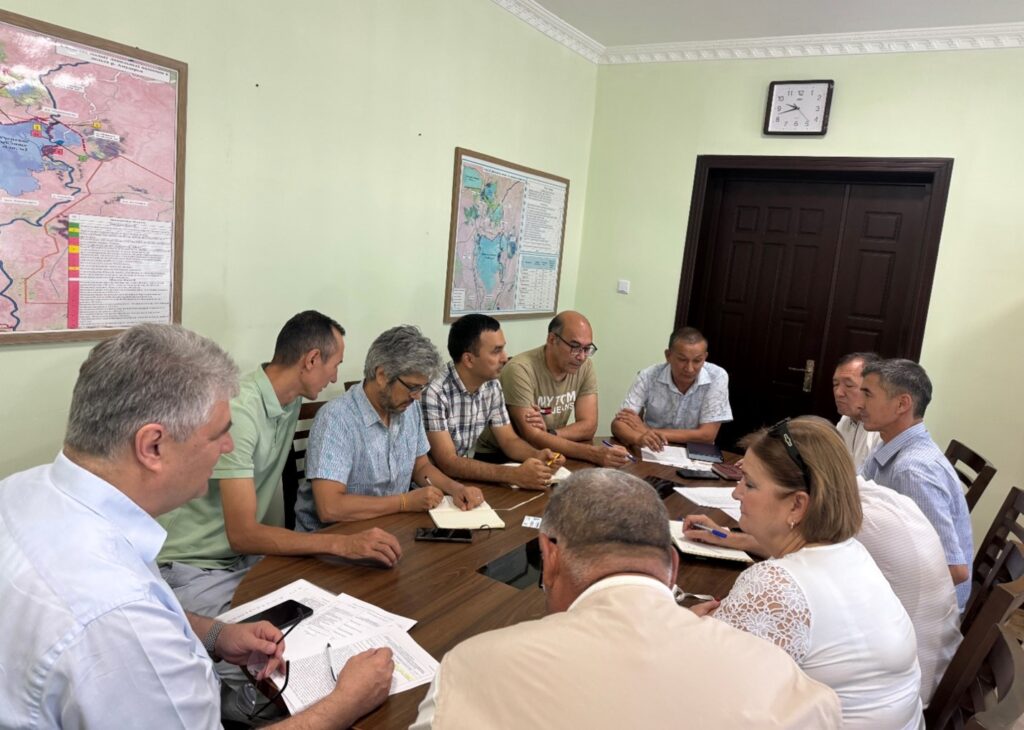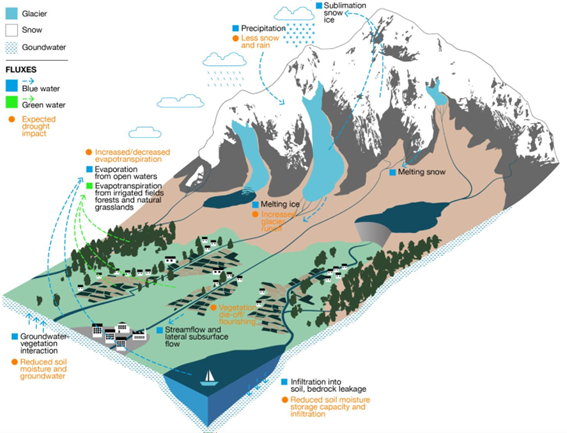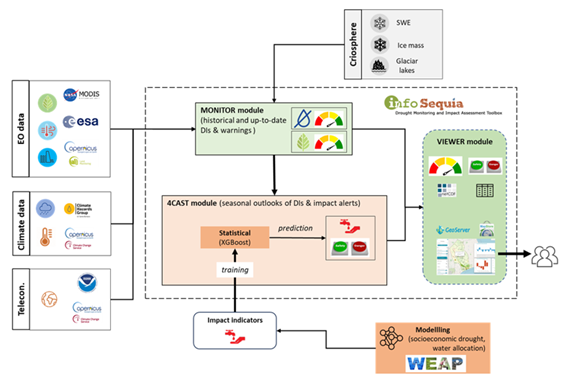To ensure effective implementation, FutureWater will maintain continuous engagement with ARA-Sul, providing technical support and collecting feedback through online sessions. This collaboration will help address challenges in system integration, troubleshoot issues, and refine functionalities. A significant component of this phase is the development of a comprehensive user manual and training materials, including PowerPoint slide decks, to guide ARA-Sul staff in effectively utilizing the tool for water licensing assessments. By embedding the tool within ARA-Sul’s operations, FutureWater aims to enhance decision-making capabilities and streamline the management of water resources in the region.
Het Interregionale Technische Platform voor Waterschaarste (iRTP-WS), geleid door de Voedsel- en Landbouworganisatie (FAO) van de Verenigde Naties, heeft als doel om de kloof tussen praktijk en innovatie te overbruggen om transformatieve veranderingen in water-, land- en landbouwbeheer te stimuleren, vooral in het licht van klimaatverandering. De focus ligt op het verbeteren van de paraatheid van systemen voor water-, voedsel- en klimaatuitdagingen door middel van beter bestuur, capaciteitsopbouw en e-learning.
Voor 2024-2025 richt het werkplan zich op “Geïntegreerde Wateroplossingen: Navigeren door Klimaatverandering en Water-Energie-Voedsel-Ecosysteem (WEFE) Nexus Dynamiek.” Het FAO Regionale Kantoor voor Azië en de Stille Oceaan leidt Strategische Prioriteit 1: Nexus Denken, waarbij cross-sectorale en inclusieve besluitvorming wordt bevorderd om hulpbronnen optimaal te benutten en duurzame WEFE-gebaseerde oplossingen te implementeren.
Om besluitvorming op basis van de nexus-benadering te ondersteunen, ontwikkelt de FAO, in samenwerking met FutureWater, een tool die gebruik maakt van Water Accounting-gegevens om toegankelijke inzichten in WEFE-dynamiek te bieden. Deze tool zal WEAP en de bijbehorende API integreren in een Excel-omgeving, waardoor scenarioanalyses voor zowel projecties als interventies worden gestroomlijnd. Door de krachten van beide platforms te combineren, biedt het een intuïtieve, gestandaardiseerde en collaboratieve benadering van Water Accounting, wat bijdraagt aan een meer geharmoniseerd besluitvormingskader.
A consortium of international development finance institutions led by World bank and including Asian Development Bank (ADB) have signaled their intention to support the financing of the Project. ADB is committed under Strategy 2030 operating priority 3 to support its Developing Member Countries to ensure a comprehensive approach to build climate and disaster resilience. The climate risk management approach of the ADB aims to reduce risks resulting from climate change to investment projects by identifying climate change risks to project performance in the early stages of project development, and which will support decision-making to incorporate the most appropriate adaptation measures in the design.
An initial climate risk assessment has been completed for the Rogun HPP project including assessments of natural hazards, hydrology, sedimentation, and the impact of climate change projections on project performance, however downstream resource implications have not been assessed. In this project FutureWater addresses wider system-level adaptation needs across the Amu Darya basin due to increased water use demand during the Rogun HPP reservoir filling period, climate-driven change to water supply and demand, and identification of potential supply-demand gaps. A combination of hydrological and water allocation modeling will form an evidence-base to inform recommended adaptive measures for the design and operation of Rogun HPP and for wider water-use sectors where required.
FutureWater undertakes analysis to understand projected climate change driven changes in water supply in Rogun HPP upstream areas, and water demands in downstream areas and the wider Amu Darya basin, with a focus on identifying the potential for a supply-demand gap throughout the Rogun HPP reservoir filling period to 2040. Where a risk of a supply-demand gap is identified FutureWater provides recommended measures that can increase water efficiency in the competing demand use sectors with the overall aim of meeting demand across the different scenarios and in compliance with cross-boundary resource sharing agreements.
Specifically, FutureWater addresses following topics:
- Model projected water supply and demand in the Amu Darya river basin by utilizing a WEAP model developed for water supply, demand and allocation analysis, and accounting for climate change, Rogun HPP reservoir filling schedule, changing hydrology patterns and changes to downstream water demand from irrigation and other relevant end-use demands, where relevant.
- Analyze the potential for water resource supply-demand gap to 2040 for a range of climate scenarios that capture potential future pathways aligned to government plans and policies and climate change, where relevant.
- Recommend required water efficiency measures, where a risk of a supply-demand gap is identified under the the limits set by the cross-border water resource sharing agreement, so as to mitgate the risk with high-level cost estimate where capital investment is required.
The Food and Agriculture Organization (FAO) launched the Asia-Pacific Water Scarcity Program (WSP) to help countries across the region address the increasing challenges of water scarcity. The program aims to promote sustainable water use and support economic productivity despite growing water constraints.
Mongolia’s inclusion in the WSP presents a valuable opportunity to strengthen its water management capabilities. By applying proven methodologies and resources, the program will enhance the capacity of Mongolia’s Water Resource Ministries and River Basin Organizations (RBOs) to tackle the country’s unique water challenges effectively.
To demonstrate the effectiveness of Water Accounting for improved water management under a changing climate, FutureWater, with FAO’s support, is conducting a Water Accounting assessment for Mongolia’s two key river basins—the Tuul and Orkhon. Using cutting-edge techniques and tools, this initiative will provide critical insights to support sustainable water allocation and long-term resilience.
The UNDP is implementing the project “Conservation and sustainable management of lakes, wetlands, and riparian corridors as pillars of a resilient and land degradation-neutral Aral basin landscape supporting sustainable livelihoods” to enhance the resilience of the ecosystems and livelihoods in Lower Amudarya and Aral Sea Basin (LADAB) through land degradation neutrality (LDN) compatible integrated land-water management.
This assignment contributes to water allocation analysis and the development of water supply scenarios for irrigated agriculture and biodiversity conservation reports. The services consist in:
- Consulting with project experts, government agencies, local communities, and other relevant stakeholders
- Develop a hydro-economic water allocation model for the lower Amu Darya basin using WEAP
- Explore different scenarios for irrigated agriculture and biodiversity conservation, considering climate change, to strike a balance between sustainable agricultural practices and conservation of biodiversity and ecosystems and (iv) build capacity and support project experts and relevant stakeholders on water allocation analysis and modelling.

Het meest recente onderzoek heeft zich gericht op het identificeren van historische megadroogtes op basis van paleo-gegevens en het begrijpen van hun klimatologische oorzaken, of op de studie van “moderne” gebeurtenissen en hun impact, meestal in laagland- en vlakke regio’s. Hooggebergteregio’s en sneeuwafhankelijke stroomgebieden zijn echter weinig bestudeerd, en er is weinig bekend over de impact van megadroogtes op de toestand en dynamiek van de cryosfeer in bergwatertorens.
Over het algemeen hebben stroomgebieden die afhankelijk zijn van hooggebergtesystemen een intrinsieke capaciteit om het gebrek aan neerslag en overmatige evapotranspiratie te bufferen, afhankelijk van de waterreserves opgeslagen in de cryosfeer (sneeuw, gletsjers en permafrost). Er wordt aangenomen dat deze buffercapaciteit beperkt is tot een kantelpunt wordt bereikt, waarna de impact van watertekorten en temperatuur-extremen kan worden versterkt en het functioneren van ecosystemen en watersystemen in gevaar kan brengen.
MegaWat heeft een dubbele doelstelling: 1) het aanpakken van kennisgebreken over de hydroklimatologische oorzaken van extreme droogtes en hun impact op de waterbalans van de bergwatertorens van Europa, met speciale nadruk op het samenvallen van samengestelde gebeurtenissen en cascade- en multischaleffecten, en 2) het ontwikkelen en voorstellen van nieuwe adaptatiestrategieën om om te gaan met de duur, omvang en ernst van toekomstige megadroogtes en hun potentiële impact op milieu- en sociaaleconomische activa.
Voor de uitvoering richt MegaWat zich op de hooggebergteregio’s van Europa en hun afhankelijke stroomgebieden. MegaWat streeft naar de ontwikkeling van drie producten:
- Product 1. Een methodologisch kader voor de identificatie en karakterisering van historische megadroogtes tijdens de instrumentele periode, en de beoordeling van de rol van de cryosfeer bij het ondersteunen van de landschapsontwikkeling van stroomafwaartse gebieden, of bij het bufferen van klimaatveranderingseffecten. Product 1 is gebaseerd op een combinatie van klimaatregionalisatie, modellering van de oppervlakte-energiebalans, hydrologische simulatie en analyse van waterevaluatie en -toewijzing op stroomgebiedniveau (zie onderstaande figuur).
- Product 2. Een hoog-resolutie, open-toegang, geregionaliseerde klimaatdatabase.
- Product 3. Een lijst van potentiële adaptatiestrategieën die nuttig zijn voor de preventie en mitigatie van droogteeffecten, en voor de versterking van de waterveiligheid en veerkracht van hooggebergteregio’s en afhankelijke stroomgebieden. Deze scenario’s worden overeengekomen met regionale en lokale actoren en belanghebbenden, en hun effectiviteit wordt geëvalueerd onder extreme droogtescenario’s in drie pilotregio’s in Europa. Deze pilotregio’s worden vooraf geselecteerd op basis van criteria van representativiteit, strategisch belang en kwetsbaarheid voor droogtes.

FutureWater speelt een belangrijke rol in MegaWat door het coördineren van het werkpakket dat tot doel heeft simulatie-instrumenten te ontwikkelen en te testen die helpen bij de aanpassing aan megadroogtes en het ondersteunen van het besluitvormingsproces. Twee specifieke doelstellingen worden nagestreefd in dit werkpakket: a) de ontwikkeling van een methodologisch prototype voor het kwantificeren van impacten en het identificeren van kantelpunten voor waterveiligheid in sneeuwafhankelijke stroomafwaartse stroomgebieden, en b) de generatie en integratie van sneeuwdroogte-indicatoren in het Drought Early Warning System van FutureWater, genaamd InfoSequia (zie onderstaande figuur).

Een one-pager kan hier worden gedownload.
Erkenningen
Dit project heeft financiering ontvangen van het Water4All-programma met cofinanciering van CDTI (Spaanse Dienst voor Wetenschap en Technologie) en het Horizon Europe-kaderprogramma van de EU voor onderzoek en innovatie.
Increasing water scarcity continues to threaten the agricultural sector in Asia. To address this critical issue, FAO and its partners have been developing a comprehensive Asia-Pacific Water Scarcity Programme (WSP) since 2019. The program aims to assess the ongoing issue of water scarcity in the region, evaluate potential management options, and assist partner countries in implementing adaptive management in the agricultural water sector using innovative tools and approaches.
Addressing the issue of water scarcity requires a sound understanding and development of water accounts to ensure evidence-based decision-making for equitable use and allocation of water resources under a changing climate. To achieve this, a comprehensive hands-on training program on water accounting will be developed and implemented across four countries: Indonesia, Lao PDR, Vietnam, and Thailand. In collaboration with the Regional Office for Asia and the Pacific (RAP) of the Food and Agriculture Organization of the United Nations (FAO), FutureWater will design and deliver the water accounting training program. This program aims to not only improve participants’ understanding of water accounting but also enable them to use modern and innovative tools to develop water accounts, with a particular focus on quantifying linkages between field interventions and basin-scale hydrology.
Participants will work with tools such as REWAS and Follow the Water (developed by FutureWater in collaboration with FAO) to conduct water accounting in agricultural systems at different scales. Through the use of these tools, participants will be able to estimate real water savings at system and basin scales and analyze the impact of different irrigation schemes on the overall water availability in the system. Moreover, participants will also learn how to access and extract remotely sensed datasets to assess the status of the water resources in the Nam Ngum pilot basin.
The aim is to develop a business case for a Watershed Investment Program for Addis Ababa. It includes stakeholder and governance analysis, scientific modeling, return on investment (ROI) analysis, and an implementation plan. Hydrological models are employed to assess the potential of Nature-based Solutions to mitigate the negative trends in the watershed, and improve water supply reliability, water quality, sedimentation and agricultural productivity. The study should raise awareness for all key stakeholders and potential investors. The study is performed under the Nature for Water Facility launched by The Nature Conservancy.
Southern Spain is a highly productive agricultural region, but with huge challenges around water scarcity and environmental sustainability. There is a demand in the agricultural sector to work towards water stewardship in Spain. The Alliance for Water Stewardship has developed a Standard which helps retailers and their suppliers to cause change at scale. This approach recognizes that there are common challenges that could be more easily overcome through a collective, place-based approach.
In the Doñana region, berry farms and groundwater usage are causing a conflict with the unique ecosystems in the National Park. A catchment assessment and active stakeholder engagement is needed as a first step in this region to work towards water stewardship. The catchment assessment will provide information on the catchment context, in line with the requirements of the Standard. The purpose of the assessment is to reduce the burden on agricultural sites by providing them with a common set of information which they and others can use to inform responses to their shared water challenges.
FutureWater will develop a high-level climate change and adaptation assessment for Turkmenistan to strengthen the water and agriculture sector’s resilience against climate change. The work involves a detailed hazard mapping exercise, employing observational and satellite-based information, to identify climate-related risks such as droughts, water scarcity, heat, salinity, erosion, and floods. These mapped hazards will be synthesized at the administrative level, presenting a comprehensive visual representation through figures and tables.
Key exposure and vulnerability datasets will be mapped, and pertinent sources for subsequent collection and analysis will be identified, setting the stage for a detailed risk assessment beyond the scope of work. The key output of this effort is the assembly of an inventory of climate adaptation measures gleaned from existing reports and official documents, contextualized to Turkmenistan’s unique circumstances, and an initial gap and opportunity assessment based on this inventory.
Based on the assessment, the adaptation options will be categorized and an initial prioritization will take place based on each option’s potential to mitigate risks across various hazards, its capacity for impactful outcomes beyond local scales, and a relative indication of expected cost-effectiveness. The outcome should provide a foundation for an integrated climate adaptation project. Concurrently, FutureWater will engage in country consultations, collaborating with stakeholders to confirm or refine identified adaptation options. These consultations will also explore potential synergies with ongoing and planned projects initiated by both the government and development partners.

